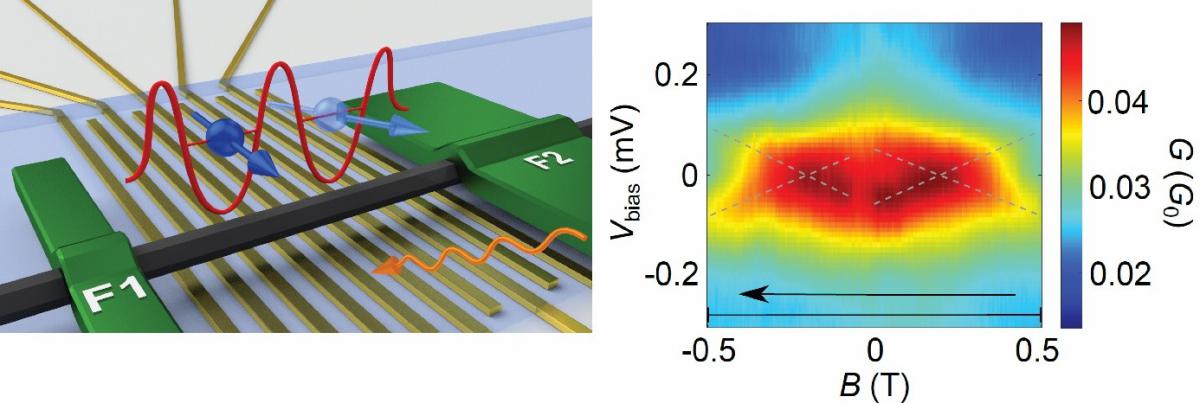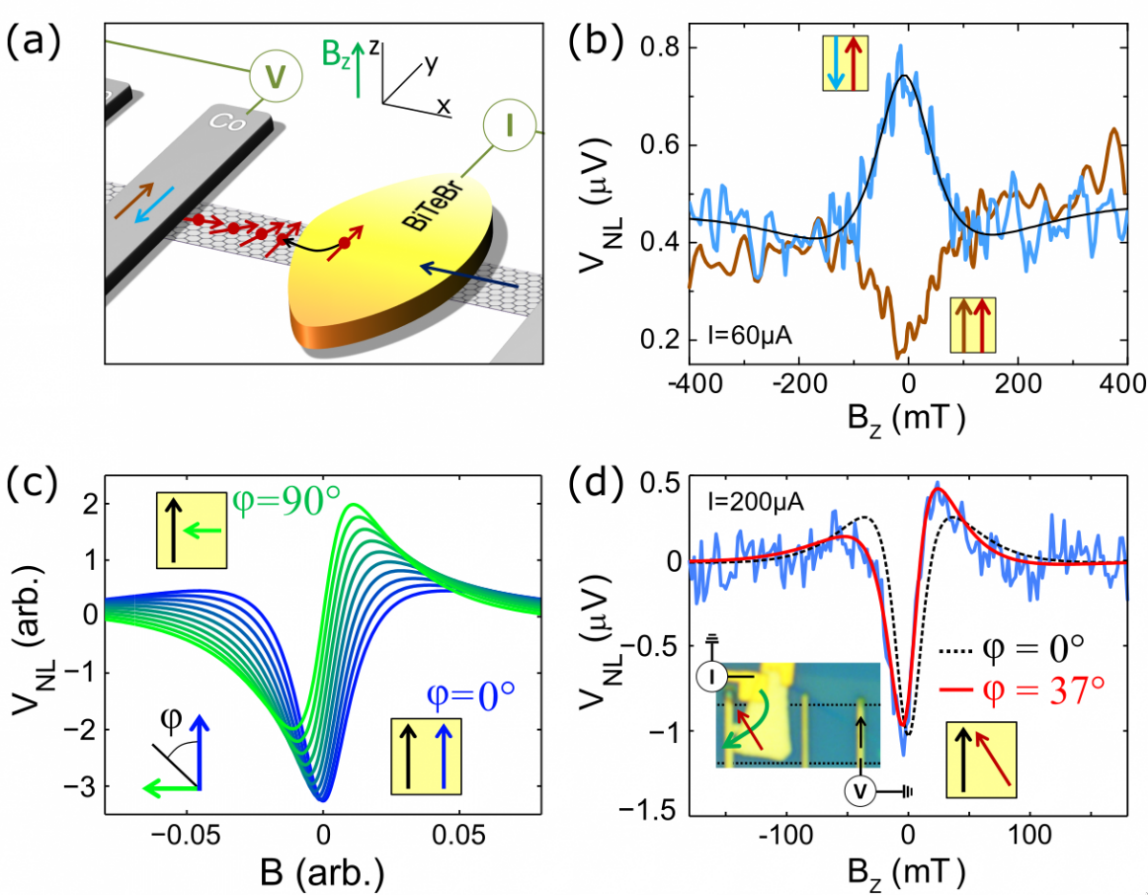One of the main directions in our group is spintronics. In the field of spintronics the idea is to use the spin of an electron for information manipulation and storage rather than its charge. This is a really wide research field from spin qubits to more classical spin-valve devices. Our work concentrates on spintronics in low dimensional materials, including InAs nanowires, and quantum dots formed within and 2D materials like graphene or BiTeBr. In these structures the special symmetry of materials together with spin-orbit interactions can lead to the appearance of topological structures, which can be harnessed for e.g. robust information storage.
Topology in NWs
Recently we have investigated the topological structure of double quantum dots in InAs wires. Using cotunnelling spectroscopy we have determined the phase diagram of double dots with strong spin- orbit coupling in finite magnetic fields. By rotating the magnetic fields in different directions we have found two directions where the ground state of the system is degenerate. We have shown, that independent of the exact details of the system, there should exists at least two of such points, which also have the same topology as the Weyl points in Weyl semimetals. These so-called magnetic Weyl points are topologically protected [1].
 |
| Top: Artistic view of the nanowire circuit used to measure the magnetic Weyl points. The colormap on the right show the evolution of excited states with magnetic field, with the appearance of Weyl points shown with the arrow. Bottom: Hamiltonian of the spin model with a general exchange interaction and the corresponding spectra. The right image shows the appearance of Weyl points in the parameters space. |
Spintronics in NW circuits
We have also studied InAs nanowire based quantum dots systems coupled to ferromagnetic electrodes. The ferromagnetic electrode leads to exchange interactions on the dot and can be detected e.g. in Kondo system, where it results in the splitting of the Kondo resonance. We have also investigated the competition between superconducting correlations and exchange [2-4]. Finally, using weak anti-localization studies we have shown a gate tunable spin-orbit interaction [5].
 |
| Double quantum dot circuit coupled to ferromagnetic electrodes (left). Induced exchange is measured by splitting of a Kondo resonance (right). |
Spin transport in Gr/2D materials
Graphene is an ideal material for spintronics, due to the large mobility and long spin relaxation times in it. However, there are still challenges in graphene based spintronics, like the electrical manipulation of spin current via spin-orbit interaction or the electrical generation of spin currents.
The BiTeX (X=I,Br,Cl) material family is fascinating, as it has one of the strongest Rashba SOI of any bulk materials and allows the electrical generation of spin currents via the Rashba-Edelstein effect (REE). It can be used as a current controlled spin injector. By injecting current into a clean graphene strip through BiTeBr, the direction and amplitude of the charge current can be used to control the polarization of the injected spins. To measure these effects spin valve devices were prepared in collaboration with the group of Saroj Dash at the Quantum Device Physics Laboratory of Chalmers University of Technology, which allowed Hanle spin precession measurements. These experiments allowed not only the demonstration of spin injection, but the measurement of the angle of the injected spins as well, showing that giant Rashba-type materials are promising new building material for spintronic applications [6].
 |
| Spin injection using BiTeBr. Top row shows the device architecture and a Hanle measurement. Bottom row show the effect of non-collinear electrodes on a Hanle measurement and an experiment showing asymmetric Hanle curves with BiTeBr spin injector. |
In BiTeBr the strong Rashba-type SOI splits up the band structure such, that two subbands are formed with opposing spin helicities. One of the way this giant Rashba-type SOI manifests, is the presence of nonreciprocal resistance in an in plane magnetic field. This means that the resistance of the sample changes when the direction of the current is reversed. As the amplitude of this difference is inversely proportional to the square of the electron density, it can be controlled by gating. To achieve strong enough gating, we used ionic liquid (IL) gating in collaboration with the group of Justin Ye at the Device Physics of Complex Materials unit of the University of Groningen. By building heterostructures where the BiTeBr is protected from the IL by a thin layer of hBN, we were able to show direct control of the strength of the nonreciprocity for the first time [7].
 |
| Ionic liquid gating on BiTeBr nanocircuit (artistic view – left, optical image of BiTeBr flakes – centre). Right panel shows an accumulation or depletion layer in BiTeBr (red) from ionic gating |
Spin-orbit engineering in graphene
Graphene is predicted to be a topological insulator, however, this intrinsic spin-orbit coupling is small. It has been found, that the spin-orbit coupling can be increased by placing it on WSe2. In collaboration with the Nanoelectronics group of Basel, we have measured high quality Gr/WSe2 heterostructures. Using weak anti-localization measurements we have revealed a large spin relaxation anisotropy and dominating Valley-Zeeman spin-orbit coupling [8].
 |
| An artistic view of a graphene sample with a valley dependent magnetic (Valley-Zeemann) field. Anti-localization curve showing the presence of spin orbit interaction. |
References
[1] Z. Scherübl, A. Pályi, Gy. Frank, I. E. Lukács, G. Fülöp, B. Fülöp, J. Nygård, K. Watanabe, T. Taniguchi, G. Zaránd & Sz. Csonka: Observation of spin–orbit coupling induced Weyl points in a two-electron double quantum dot, Nature Communications Physics, 2, 108 (2019)
[2] L. Hofstetter, A. Geresdi, M. Aagesen, J. Nygard, C. Schönenberger, S.Csonka: Ferromagnetic Proximity Effect in a Ferromagnet–Quantum-Dot–Superconductor Device, Phyiscial Review Lettters 104, 246804 (2010)
[3] H. Soller, L. Hofstetter, S. Csonka, A. Levy Yeyati, C.Schönenberger, A. Komnik: Kondo effect and spin-active scattering in ferromagnet-superconductor junctions, Phyiscal Review B 85, 174512 (2012)
[4] S. Csonka, I. Weymann, G. Zarand: An electrically controlled quantum dot based spin current injector, Nanoscale 4, 3635 (2012)
[5] Z. Scherübl, G. Fülöp, M. H. Madsen, J. Nygård, S. Csonka: Electrical tuning of Rashba spin-orbit interaction in multigated InAs nanowires, Phys. Rev. B 94, 035444 (2016)
[6] Z. Kovács-Krausz, A. Hoque, P. Makk, B. Szentpéteri, M. Kocsis, B. Fülöp, M. V. Yakushev, T. V. Kuznetsova, O. E. Tereshchenko, K. A. Kokh, I. E. Lukács, T. Taniguchi, K. Watanabe, S. P. Dash, and S. Csonka: Electrically Controlled Spin Injection from Giant Rashba Spin–Orbit Conductor BiTeBr, Nano Lett., 20, 7, 4782 (2020)
[7] M. Kocsis, O. Zheliuk, P. Makk, E. Tóvári, P. Kun, O. E. Tereshchenko, K. A. Kokh, T. Taniguchi, K. Watanabe, J. Ye, Sz. Csonka, In situ tuning of symmetry-breaking induced non-reciprocity in giant-Rashba semiconductor BiTeBr, arXiv:2008.06003
[8]S. Zihlmann, A. W. Cummings, J. H. Garcia, M. Kedves, K. Watanabe, T. Taniguchi, C. Schönenberger and P. Makk, Large spin relaxation anisotropy and valley-Zeeman spin-orbit coupling in WSe 2 /graphene/ h -BN heterostructures, Phys. Rev. B 97, 075434 (2018)

